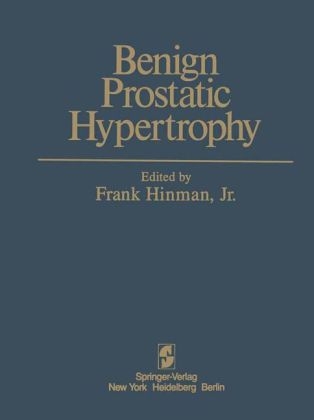
Benign Prostatic Hypertrophy
Springer-Verlag New York Inc.
978-0-387-90779-6 (ISBN)
- Titel ist leider vergriffen;
keine Neuauflage - Artikel merken
Section I Evolution of Benign Prostatic Hypertrophy and History of Treatment.- 1 Natural History of Benign Prostatic Hypertrophy.- 2 Origins, Distribution, and Risk of Benign Prostatic Hypertrophy.- 3 Interracial Incidence of Benign Prostatic Hypertrophy.- 4 Prostatic Obstruction in Chinese Populations.- 5 History of Nonsurgical Treatment.- 6 Prostatectomy: Past and Present.- 7 Suprapubic Prostatectomy: An Anglo-American Success Story.- Section II Structure and Function.- 8 Surgical Pathology of Benign Prostatic Hyperplasia.- 9 Immunological Aspects of Benign Prostatic Hypertrophy.- 10 Histochemistry.- 11 Stereological Analysis: An Approach to the Pathogenesis of Benign Prostatic Hyperplasia.- 12 Stromal-Epithelial Interaction.- 13 Origins of Benign Prostatic Hypertrophy.- 14 Possible Causative Factors.- 15 Relationship of the Origin of Benign Prostatic Hypertrophy to Prostatic Structure of Man and Other Mammals.- 16 The Relationship Between Benign Prostatic Hyperplasia and Prostatic Carcinoma.- Section III Endocrine Control.- 17 Endocrine and Cellular Inductive Factors in the Development of Human Benign Prostatic Hypertrophy.- 18 Cellular Growth and Hormone Receptors.- 19 Current Models and Their Relation to Human Disease.- 20 Effects of Castration, Estrogen, and Androgen Administration.- 21 Androgen Levels and Binding in Benign Prostatic Hyperplasia.- 22 Laboratory Evidence of Endocrine Effects.- 23 Effect of Hormones on Established Prostatic Hypertrophy.- 24 Human Trials of Endocrine Management.- 25 Treatment with Cyproterone Acetate and/or Bromocriptine.- 26 Megesterol Acetate in Treatment.- 27 Effect of Cholesterol-lowering Agents.- 28 Assessment of Medical Treatment.- 29 Directions for Future Research.- Section IV Neurophysiology of Obstruction.- 30 Coordination in Bladder Function.- 31 Autonomic Muscular Innervation of the Vesical Outlet and Its Role in Micturition.- 32 Autonomic Innervation of the Prostate.- 33 Urethrovesical Reflexes and Their Inhibition.- 34 Mechanisms of Autonomic Drug Action on the Bladder Outlet.- 35 Effect of Nonautonomic Drugs on the Vesical Neck.- 36 Pharmacological Receptors in the Prostate.- 37 Changes in Adrenergic Receptors in Bladder Outlet Obstruction.- 38 Principles for Evaluation of Pharmacologic Agents.- 39 Pharmacological Management of Outlet Obstruction.- 40 Prospects for Pharmacologic Management.- Section V Urodynamic Evaluation of Obstruction.- 41 The Physical Basis of Obstructive Uropathy.- 42 Detrusor Energy Factors.- 43 Detrusor as the Energy Source of Micturition.- 44 The Contribution of the Bladder Outlet to the Relation Between Pressure and Flow Rate During Micturition.- 45 Dynamics of Acute Retention.- 46 Clinical Significance of Urodynamic Measurements.- 47 Hydrodynamic Significance of Flow Rate Determination.- 48 Urinary Flow Rates: Measurement and Adjustment.- 49 Development of Nomograms for Application of Uroflowmetry.- 50 Urinary Velocity in Prostatism.- 51 The Video-Audio Voiding Cystourethrogram and Synchronous Pressure-Flow Cystourethrography.- 52 High-flow High-pressure Obstruction.- 53 The Urinary Drop Spectrometer in Diagnosis.- 54 Information Content of Urodynamics.- 55 Urethral Pressure Profiles.- 56 Urethral Static Pressure Profile.- 57 Residual Urine: Measurement and Influence on Management of Obstruction.- 58 Correlation of Flow Rate and Residual Urine with Symptomatology.- 59 Ultrasound Evaluation of Prostatic Size and Residual Urine.- 60 Use of the Intravenous Urogram in Diagnosis.- 61 The Intravenous Urodynamogram.- 62 Relationship Between Clinical Urodynamics and Pathologic Findings in Prostatic Obstruction.- 63 Urodynamic Interpretation of Symptoms.- 64 Future Prospects for Urodynamic Study in Clinical Evaluation of Benign Prostatic Hypertrophy.- Section VI Local Effects of Obstruction.- 65 Effects of Aging and Prostatic Obstruction on Detrusor Morphology and Function.- 66 Detrusor Morphology in Relation to Bladder Outflow Obstruction and Instability.- 67 Surgical Anatomy of the Prostatic Lobes.- 68 Relation of Prostatic Lobes to Degree and Rate of Obstruction.- 69 The Development of Vesical Trabeculation.- Section VII Secondary Effects of Obstruction.- 70 Sequential Events in Prostatic Obstruction.- 71 The Symptoms of Bladder Outlet Obstruction: Detrusor Dysfunction and the Myth of “Prostatism”.- 72 Obstruction and the Uninhibitable Detrusor.- 73 Progression of Obstruction and Symptoms.- 74 Diseases Complicating Management of Benign Prostatic Hypertrophy.- 75 Bacterial Prostatitis and Benign Prostatic Hypertrophy.- 76 Infection and Stasis.- 77 Effect of Obstruction on Renal Function.- Section VIII Indications for Operation.- 78 Differential Diagnosis.- 79 A Point System for Selecting Operative Candidates.- 80 Prostatic Health Status Index.- 81 Indications for Prostatectomy—Mandatory and Optional.- 82 Prostatectomy in Vesical Neurological Disturbances.- 83 Role of Self-Catheterization in Prostatism.- 84 Distention Therapy in Early Stages.- Section IX Surgical Treatment.- 85 The Anatomical Objectives of Operation.- 86 Selection of Operations.- 87 The Sphincter Mechanisms: Their Relation to Prostatic Enlargement and Its Treatment.- 88 Transurethral Prostatectomy.- 89 Internal Urethrotomy.- 90 Water Intoxication.- 91 Risk Management Program in Electrosurgery.- 92 Perioperative Antibiotics.- 93 Consequences of Incomplete Prostatic Transurethral Resection.- 94 Suprapubic Prostatectomy.- 95 Simple (Conservative) Perineal Prostatectomy.- 96 Retropubic Prostatectomy.- 97 Reconstructive Posterior Prostatectomy.- 98 Cryosurgical Treatment.- Section X Results of Surgery.- 99 Psychosexual Counseling: Informed Consent.- 100 Urodynamic Results of Surgery.- 101 Evaluation and Management of Symptoms After Prostatectomy.- 102 Late Results and Complications of Prostatectomy.- 103 Postprostatectomy Strictures.- 104 Postprostatectomy Incontinence: Urodynamic Evaluation.- 105 Postprostatectomy Incontinence: Surgical Repair—Bladder Neck Reconstruction.- 106 Postprostatectomy Incontinence: The Artificial Sphincter.- 107 Effect of Benign Prostatic Hypertrophy and Consequent Operations on Potency.- 108 A Method for Establishing Fees.- 109 Future of Surgery for Prostatic Hypertrophy.- Section XI Annotated Bibliography.- I Evolution of Benign Prostatic Hypertrophy and History of Treatment.- II Structure and Function.- III Endocrine Control.- IV Neurophysiology of Obstruction.- V Urodynamic Evaluation of Obstruction.- VI Local Effects of Obstruction.- VII Secondary Effects of Obstruction.- VIII Indications for Operation.- IX Surgical Treatment.- X Results of Surgery.
| Verlagsort | New York, NY |
|---|---|
| Sprache | englisch |
| Themenwelt | Medizin / Pharmazie ► Medizinische Fachgebiete ► Onkologie |
| Medizin / Pharmazie ► Medizinische Fachgebiete ► Urologie | |
| ISBN-10 | 0-387-90779-3 / 0387907793 |
| ISBN-13 | 978-0-387-90779-6 / 9780387907796 |
| Zustand | Neuware |
| Haben Sie eine Frage zum Produkt? |
aus dem Bereich


